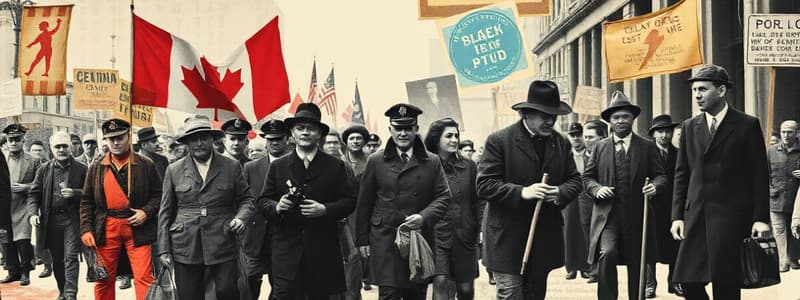Podcast
Questions and Answers
What was a primary characteristic of the preunionization work environment?
What was a primary characteristic of the preunionization work environment?
- Workers had equal bargaining power with employers.
- Unions and collective bargaining were common.
- The employer made the rules that employees had to follow. (correct)
- Employees had significant rights and protections.
During the early years before 1900, most Canadian workers were unionized.
During the early years before 1900, most Canadian workers were unionized.
False (B)
Which act required certain industries to submit disputes to a conciliation board in 1907?
Which act required certain industries to submit disputes to a conciliation board in 1907?
- Industrial Disputes Act (correct)
- Labour Standards Act
- Civil Rights Act
- Employment Relations Act
What was the primary goal of worker organizations shortly after the War of 1812?
What was the primary goal of worker organizations shortly after the War of 1812?
The Winnipeg General Strike in 1919 marked the beginning of the radical labour movement in Canada.
The Winnipeg General Strike in 1919 marked the beginning of the radical labour movement in Canada.
Under the master-servant relationship, employees had few _____ and little court protection.
Under the master-servant relationship, employees had few _____ and little court protection.
What was a significant consequence of the Great Depression on unions in Canada during the 1930s?
What was a significant consequence of the Great Depression on unions in Canada during the 1930s?
Match the terms related to the labour movement with their definitions:
Match the terms related to the labour movement with their definitions:
The _________ union was a syndicalist trade union aimed at overthrowing capitalism primarily in western Canada.
The _________ union was a syndicalist trade union aimed at overthrowing capitalism primarily in western Canada.
What did early trade or craft-based shops primarily rely on?
What did early trade or craft-based shops primarily rely on?
Match the events with their respective years:
Match the events with their respective years:
During the years 1900 to 1914 in Canada, which of the following was true?
During the years 1900 to 1914 in Canada, which of the following was true?
The relationship between the Canadian and American labour movements has not influenced each other over time.
The relationship between the Canadian and American labour movements has not influenced each other over time.
The Canadian Labour Congress was formed in 1956 after the merger of the One Big Union.
The Canadian Labour Congress was formed in 1956 after the merger of the One Big Union.
Identify one significant event from the 1850s to present that has shaped workplace relations.
Identify one significant event from the 1850s to present that has shaped workplace relations.
What year did the Berlin Convention take place, which was consistent with the American Federation of Labor?
What year did the Berlin Convention take place, which was consistent with the American Federation of Labor?
What was one of the major changes in the workplace during the Early Years before 1900?
What was one of the major changes in the workplace during the Early Years before 1900?
The Trade Union Act of 1872 eliminated the penalties for striking.
The Trade Union Act of 1872 eliminated the penalties for striking.
What was the primary goal of the Nine-Hour Movement in 1872?
What was the primary goal of the Nine-Hour Movement in 1872?
The ___ of Labor was formed in 1886 and consisted of skilled workers.
The ___ of Labor was formed in 1886 and consisted of skilled workers.
Which of the following characteristics defines the Knights of Labor?
Which of the following characteristics defines the Knights of Labor?
Match the following terms with their corresponding definitions:
Match the following terms with their corresponding definitions:
Canadian labor unions prioritized solely economic welfare.
Canadian labor unions prioritized solely economic welfare.
Who was the government leader associated with the Trade Union Act and changes benefiting labor organizations?
Who was the government leader associated with the Trade Union Act and changes benefiting labor organizations?
What was the primary purpose of the Wagner Act (1935)?
What was the primary purpose of the Wagner Act (1935)?
The Canadian P.C. 1003 (1944) granted workers the right to strike for recognition.
The Canadian P.C. 1003 (1944) granted workers the right to strike for recognition.
Who was the Justice that introduced the Rand Formula in the arbitration decision following the Ford Strike of 1945?
Who was the Justice that introduced the Rand Formula in the arbitration decision following the Ford Strike of 1945?
The merger of the Trades and Labour Congress (TLC) and Canadian Congress of Labour (CCL) formed the __________.
The merger of the Trades and Labour Congress (TLC) and Canadian Congress of Labour (CCL) formed the __________.
Which organization was responsible for creating a mechanism for workplace disputes during the life of a collective agreement in Canada?
Which organization was responsible for creating a mechanism for workplace disputes during the life of a collective agreement in Canada?
The Rand Formula requires employees to join unions in order to be employed.
The Rand Formula requires employees to join unions in order to be employed.
What was significant about the merger of the American Labour Federation and the Congress of Industrial Organizations?
What was significant about the merger of the American Labour Federation and the Congress of Industrial Organizations?
Match the following Acts/Laws with their impact:
Match the following Acts/Laws with their impact:
What significant law was enacted in 1967 that enabled federal government employees to bargain collectively in Canada?
What significant law was enacted in 1967 that enabled federal government employees to bargain collectively in Canada?
The economic and political agenda in the 1970s in Canada became more liberal.
The economic and political agenda in the 1970s in Canada became more liberal.
What program restricted labor's ability to seek wage increases in the 1970s?
What program restricted labor's ability to seek wage increases in the 1970s?
In the 1980s, a recession led to unemployment rates reaching ______ percent.
In the 1980s, a recession led to unemployment rates reaching ______ percent.
What major trade agreement was implemented in the 1990s, involving Canada, the US, and Mexico?
What major trade agreement was implemented in the 1990s, involving Canada, the US, and Mexico?
Match the decade with the key event related to labor movements.
Match the decade with the key event related to labor movements.
In the new millennium, it has become easier for workers to unionize due to better connectivity.
In the new millennium, it has become easier for workers to unionize due to better connectivity.
What was the name of the union formed when the Canadian Auto Workers (CAW) and Communications, Energy and Paperworkers (CEP) joined together?
What was the name of the union formed when the Canadian Auto Workers (CAW) and Communications, Energy and Paperworkers (CEP) joined together?
Flashcards
Preunionization Master-Servant Relationship
Preunionization Master-Servant Relationship
A system where employers held all the power and employees had very limited rights, often facing unfair treatment and coercion.
New Model Unionism
New Model Unionism
A form of early union where skilled workers in a specific trade organized to protect their interests and control who could join their trade.
Business Unionism
Business Unionism
A union that primarily focuses on improving workers' wages, benefits, and working conditions through collective bargaining.
Political Nonpartisanship
Political Nonpartisanship
Signup and view all the flashcards
Exclusive Jurisdiction
Exclusive Jurisdiction
Signup and view all the flashcards
Workplace Rights
Workplace Rights
Signup and view all the flashcards
Unionization Movement
Unionization Movement
Signup and view all the flashcards
Resulting Imbalance of Power
Resulting Imbalance of Power
Signup and view all the flashcards
Wagner Act (1935)
Wagner Act (1935)
Signup and view all the flashcards
National Labor Relations Act
National Labor Relations Act
Signup and view all the flashcards
National Labor Relations Board (NLRB)
National Labor Relations Board (NLRB)
Signup and view all the flashcards
Collective Bargaining
Collective Bargaining
Signup and view all the flashcards
P.C. 1003 (1944)
P.C. 1003 (1944)
Signup and view all the flashcards
Rand Formula
Rand Formula
Signup and view all the flashcards
Automatic Dues Check-Off
Automatic Dues Check-Off
Signup and view all the flashcards
Reconciliation and Expansion into the Public Sector
Reconciliation and Expansion into the Public Sector
Signup and view all the flashcards
The Rise of Industrial Unionization (1890s)
The Rise of Industrial Unionization (1890s)
Signup and view all the flashcards
Berlin (Kitchener) Convention (1902)
Berlin (Kitchener) Convention (1902)
Signup and view all the flashcards
Industrial Disputes Investigation Act (1907)
Industrial Disputes Investigation Act (1907)
Signup and view all the flashcards
Rapid Industrialization and Labor Unrest (1900-1914)
Rapid Industrialization and Labor Unrest (1900-1914)
Signup and view all the flashcards
Winnipeg General Strike (1919)
Winnipeg General Strike (1919)
Signup and view all the flashcards
One Big Union (1919)
One Big Union (1919)
Signup and view all the flashcards
The Great Depression and Labor's Response (1930s-1940s)
The Great Depression and Labor's Response (1930s-1940s)
Signup and view all the flashcards
The Snider Case (1925)
The Snider Case (1925)
Signup and view all the flashcards
Public Service Staff Relations Act (PSSRA)
Public Service Staff Relations Act (PSSRA)
Signup and view all the flashcards
Increased Militancy in Private-Sector Unions (1960s)
Increased Militancy in Private-Sector Unions (1960s)
Signup and view all the flashcards
Peak of Public Sector Unionism (1970s)
Peak of Public Sector Unionism (1970s)
Signup and view all the flashcards
Energy Crisis and Economic Challenges (1970s)
Energy Crisis and Economic Challenges (1970s)
Signup and view all the flashcards
Wage-Price Controls (1970s)
Wage-Price Controls (1970s)
Signup and view all the flashcards
Economic Recession and Concessions (1980s)
Economic Recession and Concessions (1980s)
Signup and view all the flashcards
Mergers of Unions (1990s)
Mergers of Unions (1990s)
Signup and view all the flashcards
Movement Toward Larger Unions (New Millennium)
Movement Toward Larger Unions (New Millennium)
Signup and view all the flashcards
Nine-Hour Movement
Nine-Hour Movement
Signup and view all the flashcards
Trade Union Act (1872) and Amendments to the Criminal Law Amendment Act (1872)
Trade Union Act (1872) and Amendments to the Criminal Law Amendment Act (1872)
Signup and view all the flashcards
American Federation of Labor (AFL)
American Federation of Labor (AFL)
Signup and view all the flashcards
Knights of Labor
Knights of Labor
Signup and view all the flashcards
Open Jurisdiction
Open Jurisdiction
Signup and view all the flashcards
Social Unionism
Social Unionism
Signup and view all the flashcards
Study Notes
Chapter 2: Labour History
- This chapter explores the history of labor relations in Canada, focusing on the evolution of the workplace environment, the relationship between Canadian and American labor movements, and divisions within the labor movement over time.
- The learning objectives include the pre-unionization work environment, the shift toward unionization, the connection between Canadian and American labor movements, and the impacts of exclusive jurisdiction, business unionism, and political nonpartisanship on labor movements.
- Significant events from the 1850s to the present day shaped workplace relationships. The chapter also examines how current and past history might affect the future of labor in Canada.
Preunionization
- The master-servant relationship characterized pre-unionization work.
- Employers dictated rules and employees had limited rights.
- Unions and collective bargaining were considered illegal.
- Employees received little protection through the courts leading to a severe power imbalance that often involved coercion.
The Movement to Unionization
- The early years (pre-1900) saw self-employment dominant.
- Workers organized to combat harsh conditions, organizing by trade or craft, with all members performing the same trade or specialized tasks.
- Crafts control the supply of labor, resolving issues via negotiation instead of strikes.
- Trades grew into factories, leading to employment in lumber mills, canneries, and coal mines.
- Profits became central.
- Mechanization led to lower labor costs because employers introduced less-skilled workers leading to workers forming craft unions.
- Increased industrialization and the growth of labor organizations followed.
Early Years (1872-1900)
- The Nine-Hour Movement (1872): Hamilton workers, with the printing industry as the main driver, launched a combined protest to shorten the workday.
- The Trade Union Act of 1872, along with its Amendments to the Criminal Law Amendment Act (1872) signified a shift in government policy toward labor relations under the leadership of John A. Macdonald.
- This period saw a change in policy, no longer considering labor organizations as conspiracies.
- Penalties for striking were initiated.
Early Labor Groups (1869-1886)
- The Knights of Labor (1869) was a radical group that wanted one big union, worker-owned cooperatives, and opposed strikes; though, they lasted a short time.
- The American Federation of Labor (AFL) (1886) was founded on the principles of exclusive jurisdiction, business unionism, and political nonpartisanship.
- These three core values shaped the American labour movement, both uniting and dividing it throughout history
American vs. Canadian Unionism
- United States (AFL): Emphasis on exclusive jurisdiction (craft-based unions), represent one specialized trade, and business unionism (focusing only on member needs)
- Canada (CLU): Emphasis on open jurisdiction (skilled and unskilled labor), focusing on social issues beyond just economic welfare (e.g., Child Labor).
Unionization in Canada: A Historical Timeline
- The chapter includes a timeline of events impacting Canadian unionization, from the late 19th century to the early 21st Century. These include significant events such as the The Berlin (Kitchener) Convention and the Industrial Disputes Investigation Act impacting labor movements.
The Years of Struggle
- Key events impacted the struggle spanning from the late 19th Century to World War I.
- The era saw larger factories, strict supervision, coercive drives, and significant involvement by American labor organizations to lead Canadian workers.
- Notable incidents included the 1907 Coal strike, which led to the introduction of the Industrial Disputes Investigation Act (1907), a landmark piece of Canadian labor law.
- The period between 1900-1914 was particularly eventful, with rapid economic growth and increased strike activity.
- The 1919 Winnipeg General Strike was a significant turning point, marking the end of a period of intense radical labor activity in Canada.
Decline and Resurrection (1930s-1940s)
- The Great Depression had a significant negative impact on workers' rights. Unemployment reached 32%.
- The Wagner Act (1935), also known as the National Labor Relations Act, marked an important turning point in US labor law, providing workers with greater protections and rights.
- In Canada, the Committee of Industrial Organization (CIO) (1935) and the passing of PC 1003 (1944) granted Canadian workers basic rights, and the Rand Formula (1945) provided unions with financial stability.
Reconciliation and Expansion into the Public Sector (1950s-1970s)
- Labor movements saw mergers and a shift in focus to the public sector.
- The 1960s encompassed a decade of increased radicalism in public sector unions. The Public Service Staff Relations Act (PSSRA) (1967) allowed for collective bargaining by federal government employees.
Changing Relationships with Government and USA
- The 1970s experienced economic and political shifts, creating challenges for workers.
- Inflation and unemployment increased.
- The 1980s saw a significant economic downturn.
- Concerns about free trade and NAFTA negotiations emerged
- The 1990's resulted in economic restructuring and global market factors contributing to the decline in labor's strength due to significant job losses.
Implications for the Future of Unions
- The emergence of the new millennium brought new challenges for unions.
- Larger unionization became necessary to meet the needs of a growing and changing workforce.
- The ability to maintain steady membership is key to the longevity and stability of the Canadian labor movement.
Summary
- Canadian labor history demonstrates a century of significant change.
- Initially, employees had few rights, and labor movements focused on trade unions evolving into industrial unionism.
- Legislation, shifts in public sector unionization, and government interventions have all been important factors.
- The Canadian labor movement has shown resilience despite global factors impacting labor movements globally.
Studying That Suits You
Use AI to generate personalized quizzes and flashcards to suit your learning preferences.




